By Leen Randell
Updated: Jul 08, 2024
10 Best Herbal Tinctures For Burning Feet
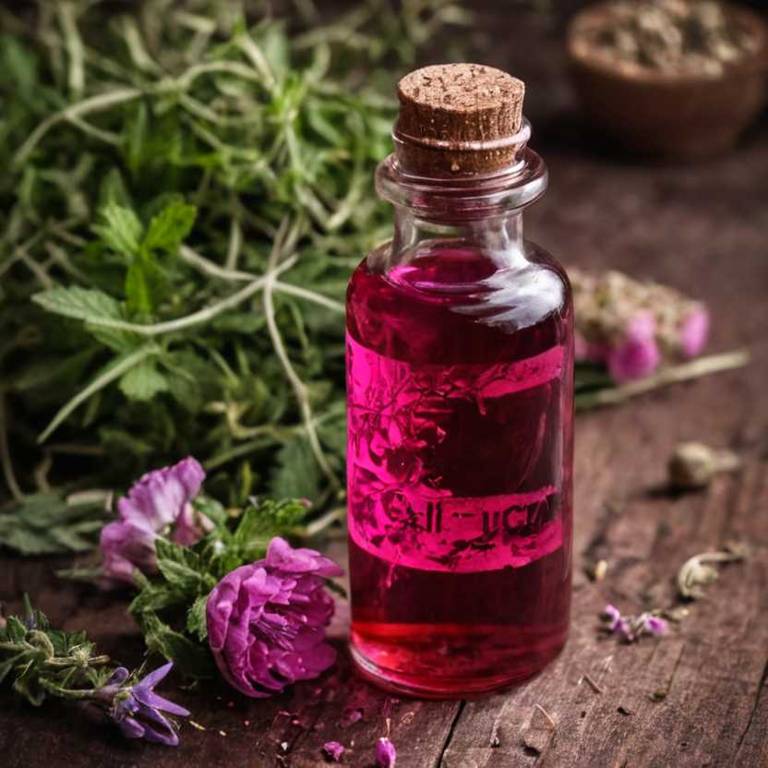
Herbal tinctures for burning feet are concentrated plant-based extracts that have been traditionally used to alleviate symptoms of burning, numbness, and tingling in the feet.
These tinctures work by soothing irritated nerves, reducing inflammation, and improving circulation. Examples include peppermint oil, which cools and calms the skin, and ginger root extract, which reduces pain and inflammation.
By using these herbal tinctures, individuals with burning feet can experience relief from discomfort, allowing them to participate in daily activities without limitation and enjoy a better quality of life.
The following article describes in detail the most important tinctures for burning feet, including medicinal properties, parts of herbs to use, and recipes for preparations.
- 1. Hypericum perforatum
- 2. Capsicum annuum
- 3. Aloe vera
- 4. Melissa officinalis
- 5. Peumus boldus
- 6. Gaultheria procumbens
- 7. Echinacea angustifolia
- 8. Arnica montana
- 9. Sambucus nigra
- 10. Calendula officinalis
- What is the best combination of herbal tinctures to use for burning feet?
- What ailments similar to burning feet are treated with herbal tinctures?
1. Hypericum perforatum
St John's wort tinctures helps with burning feet because of its anti-inflammatory properties, which help to reduce swelling and irritation in the feet.
The herb also contains compounds that have natural analgesic effects, providing relief from pain and discomfort associated with burning feet. Additionally, St John's wort has antioxidant properties that can help to protect the skin and tissues from oxidative stress, further reducing inflammation and promoting healing.
As a result, using herbal St John's wort tinctures can provide effective relief from burning feet symptoms.
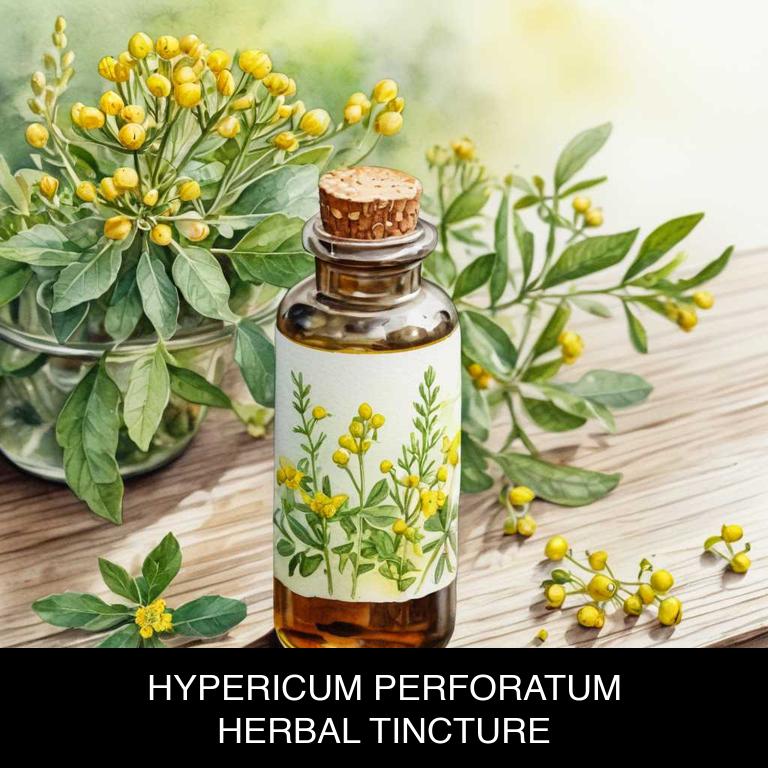
Medicinal Constituents
The list below shows the primary medicinal constituents in Hypericum perforatum tinctures that help with burning feet.
- Hyperforin: A phloroglucinol derivative that helps to reduce inflammation and pain associated with burning feet by inhibiting the release of pro-inflammatory mediators.
- Hypericin: A naphthodianthrone with potent antioxidant and anti-inflammatory properties that helps to soothe and calm burning sensations in the feet by neutralizing free radicals and reducing oxidative stress.
- Quercetin: A flavonoid with anti-inflammatory and antioxidant properties that helps to alleviate burning feet by inhibiting the production of pro-inflammatory cytokines and reducing inflammation in the affected area.
Parts Used
The list below shows the primary parts of st john's wort used to make tinctures for burning feet.
- Leaves: Their high hypericin and hyperforin content helps to soothe and calm burning sensations.
- Stems: The stems' bioactive compounds, particularly hyperforin, aid in reducing inflammation and discomfort associated with burning feet.
- Roots: The roots' rich stores of hypericin and other flavonoids contribute to their analgesic and anti-inflammatory properties, helping to alleviate burning foot symptoms.
Quick Recipe
The following recipe gives a procedure to make a basic st john's wort for burning feet.
- Gather 250 grams of dried hypericum perforatum flowers and 750 milliliters of 60 percent ethanol.
- Combine the dried flowers and ethanol in a clean glass container and seal the lid tightly.
- Steep the mixture in a cool dark place for 2 to 6 weeks shaking the container every day.
- Strain the liquid through a coffee filter or cheesecloth into another clean glass container and discard the solids.
- Transfer the tincture to dark glass bottles and store them in a cool dark place for up to 2 years.
2. Capsicum annuum
Bell pepper tinctures helps with burning feet because of its powerful anti-inflammatory properties, which alleviate discomfort and soothe irritated nerve endings.
The capsaicin content in bell peppers also acts as a natural pain reliever, numbing the affected area and reducing sensations of burning. Additionally, herbal bell pepper tinctures can help to improve circulation, allowing for better oxygenation and nutrient delivery to the feet.
This holistic approach addresses the root causes of burning feet, providing long-lasting relief from discomfort and pain.
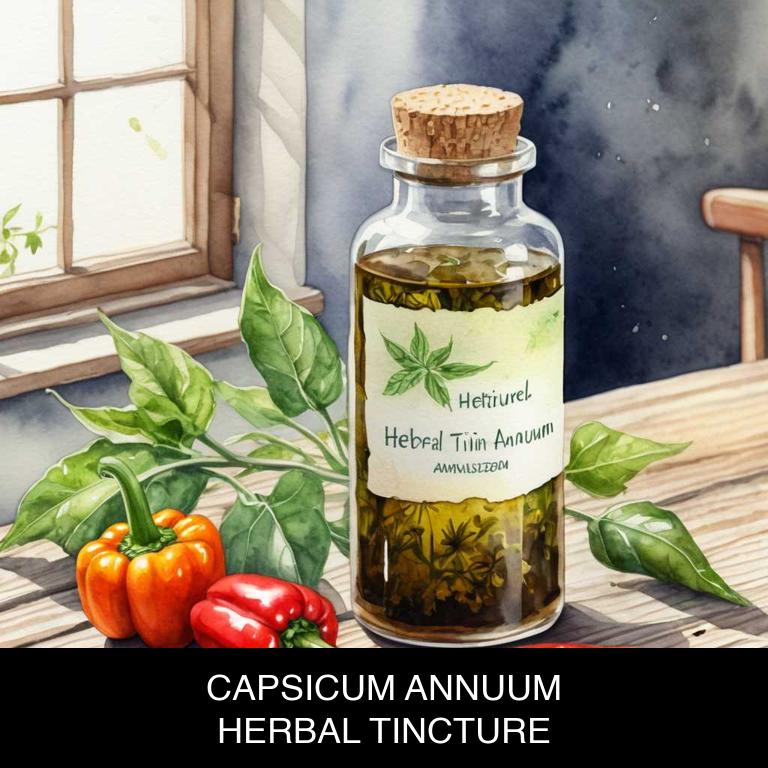
Medicinal Constituents
The list below shows the primary medicinal constituents in Capsicum annuum tinctures that help with burning feet.
- Capsaicin: Capsaicin is a potent analgesic that inhibits the production of pain-causing chemicals in the body, such as substance P, thereby reducing the sensation of burning in the feet.
- Catechins: Catechins are a type of phenolic compound found in Capsicum annuum that possess anti-inflammatory properties, which can help reduce inflammation and alleviate burning sensations in the feet.
- Flavonoids: These flavonoids exhibit antioxidant and anti-inflammatory activities, which can help reduce oxidative stress and inflammation in the feet, thereby alleviating burning sensations.
Parts Used
The list below shows the primary parts of bell pepper used to make tinctures for burning feet.
- Fruits: Fruits are the most commonly used part for tinctures due to their high concentration of capsaicin, which is responsible for the burning sensation.
- Leaves: Leaves are another commonly used part for tinctures, as they also contain capsaicin and other compounds that can help relieve pain and itching.
- Seeds: Seeds are sometimes used for tinctures, although in smaller quantities, as they contain a lower concentration of capsaicin compared to fruits and leaves.
Quick Recipe
The following recipe gives a procedure to make a basic bell pepper for burning feet.
- Harvest 1 pound of fresh capsicum annuum peppers and wash them thoroughly with clean water.
- Chop the peppers into small pieces and combine them with 2 cups of 80 proof vodka in a clean glass jar.
- Steep the mixture in a cool dark place for 2 weeks, shaking the jar every day for 10 minutes.
- Strain the mixture through a cheesecloth or coffee filter into another clean glass container, discarding the solids.
- Transfer the tincture to small dark glass bottles and store them in a cool dark place for up to 2 years.
3. Aloe vera
Aloe tinctures helps with burning feet because they possess anti-inflammatory and soothing properties that can effectively reduce discomfort and pain.
The aloe vera extract in the tincture penetrates deep into the skin, calming inflammation and irritation caused by dryness or friction. Additionally, its natural moisturizing properties help to hydrate and nourish the skin, leaving it feeling soft and calm.
This unique combination makes herbal aloe tinctures an effective remedy for soothing burning feet and promoting overall foot health.
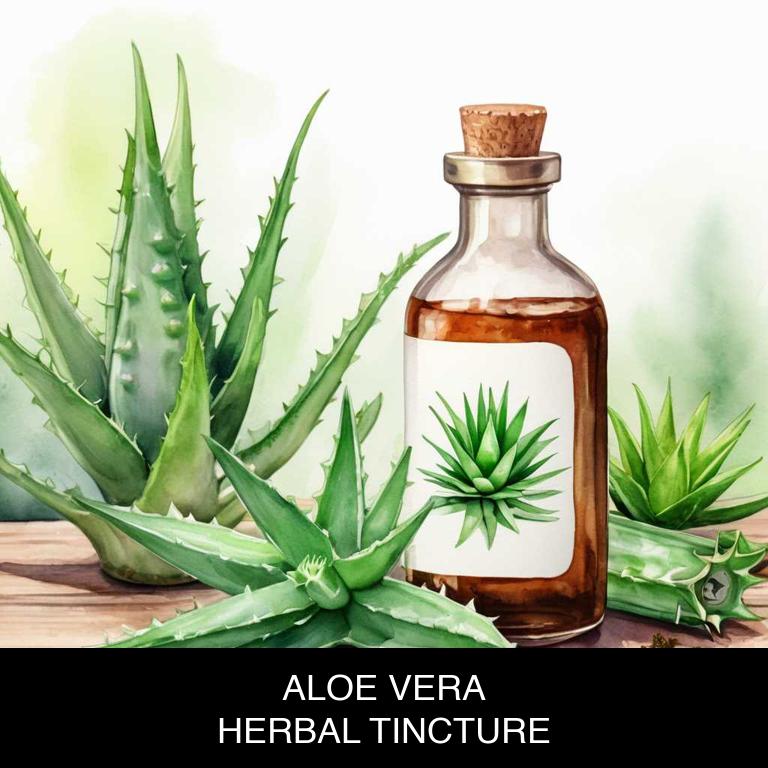
Medicinal Constituents
The list below shows the primary medicinal constituents in Aloe vera tinctures that help with burning feet.
- Glucomannan: Helps with burning feet by soothing and reducing inflammation, as it has anti-inflammatory properties.
- Aloin: Helps with burning feet by acting as a natural analgesic and anti-inflammatory agent, providing relief from pain and discomfort.
- Polysaccharides: Helps with burning feet by promoting wound healing and reducing inflammation, which in turn alleviates burning sensation and discomfort.
Parts Used
The list below shows the primary parts of aloe used to make tinctures for burning feet.
- Leaves: They are rich in aloe-emodin, which has anti-inflammatory and analgesic properties that can help soothe burning feet.
- Leaves: Aloe vera leaves also contain aloin, a compound that can reduce inflammation and promote healing in irritated skin.
- Leaves: The gel from the leaves has anti-inflammatory and moisturizing properties, which can help to calm and soothe burning feet.
Quick Recipe
The following recipe gives a procedure to make a basic aloe for burning feet.
- Harvest 20-30 mature aloe vera leaves with thick green skin and store them in a cool dry place for 2 days.
- Cut the aloe vera leaves into small pieces and remove the thick green skin to expose the gel.
- Combine 1 cup of the aloe vera gel with 2 cups of 80% ethanol in a clean glass jar.
- Seal the jar and let it steep in a cool dark place for 2-3 weeks, shaking the jar daily.
- Strain the liquid through a cheesecloth into a clean glass bottle, discarding the solids and storing the tincture in a cool dark place.
4. Melissa officinalis
Lemon balm tinctures helps with burning feet because of its natural analgesic and anti-inflammatory properties.
The active compound, rosmarinic acid, works to reduce swelling and ease discomfort in the skin, providing relief from burning sensations. Additionally, lemon balm's calming effects can help to soothe the nervous system, which may be contributing to the burning sensation.
By reducing inflammation and promoting relaxation, herbal lemon balm tinctures offer a natural solution for alleviating burning feet and promoting overall foot health.
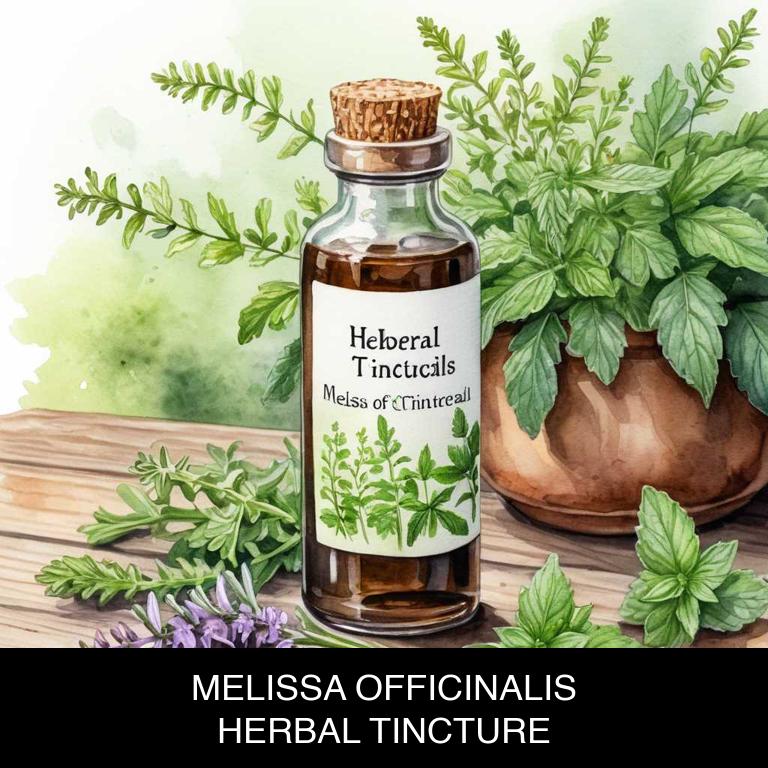
Medicinal Constituents
The list below shows the primary medicinal constituents in Melissa officinalis tinctures that help with burning feet.
- Rosmarinic acid: This phenolic compound has anti-inflammatory and antioxidant properties, which can help alleviate the inflammation and irritation associated with burning feet.
- Citral: As a terpene, citral has analgesic and anti-inflammatory effects, which can help reduce the pain and discomfort caused by burning feet.
- Nepetalactone: This iridoid has analgesic and anti-inflammatory properties, which can help soothe and calm the skin, reducing the burning sensation associated with burning feet.
Parts Used
The list below shows the primary parts of lemon balm used to make tinctures for burning feet.
- Leaves: They are rich in essential oils, which have anti-inflammatory and soothing properties that can help alleviate burning sensations.
- Stems: The stems contain a high concentration of the active compounds that can help to cool and calm the skin, reducing burning and discomfort.
- Roots: The roots are a good source of bioactive compounds that can help to reduce inflammation and provide relief from burning sensations in the feet.
Quick Recipe
The following recipe gives a procedure to make a basic lemon balm for burning feet.
- Harvest melissa officinalis flowers and leaves at dawn when oil content is highest.
- Dry the harvested melissa officinalis plant material in a single layer at 25 degrees celsius for 7 days.
- Combine 1 part dried melissa officinalis with 2 parts 80 proof ethanol in a clean glass jar.
- Steep the mixture for 2 to 4 weeks in a cool dark place with occasional shaking.
- Strain the tincture through a cheesecloth into a clean glass bottle and store in a dark place.
5. Peumus boldus
Chilean boldo tinctures helps with burning feet because it has natural anti-inflammatory properties that reduce swelling and ease discomfort.
The tincture's antispasmodic effects also help to relax and calm the nerves, alleviating burning sensations and tingling feelings in the feet.
Additionally, Chilean boldo's antioxidant properties help to protect the skin from damage caused by free radicals, promoting healthy circulation and reducing inflammation, ultimately providing relief from burning feet discomfort.
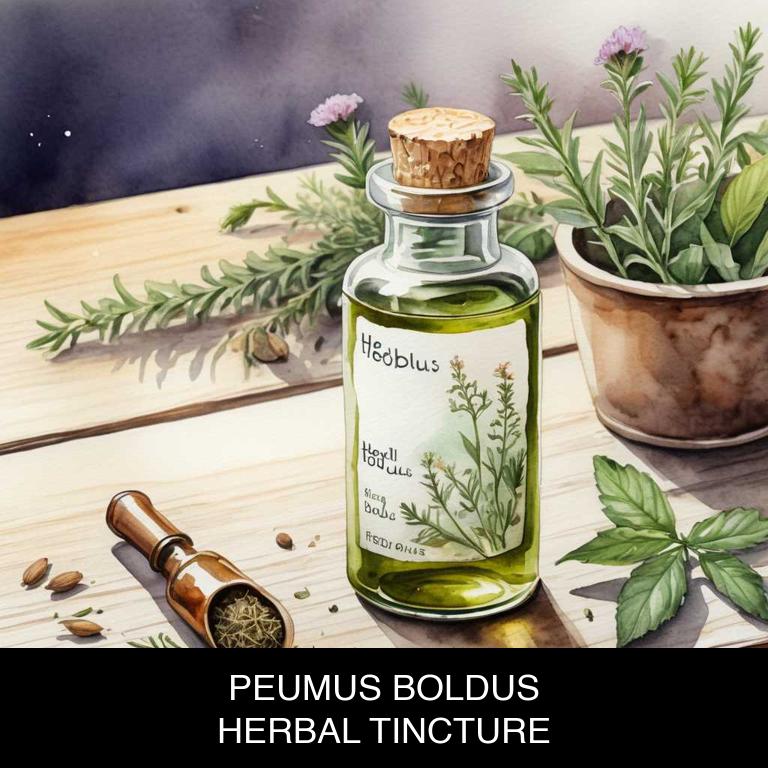
Medicinal Constituents
The list below shows the primary medicinal constituents in Peumus boldus tinctures that help with burning feet.
- Tannins: Tannins help with burning feet by reducing inflammation and acting as a natural astringent, which can help to soothe and calm irritated skin.
- Alkaloids: Boldine, an alkaloid found in Peumus boldus, has antioxidant and anti-inflammatory properties that can help to reduce pain and discomfort associated with burning feet.
- Flavonoids: Quercetin, a flavonoid present in Peumus boldus, has anti-inflammatory and antioxidant properties that can help to reduce inflammation and alleviate pain in burning feet.
Parts Used
The list below shows the primary parts of chilean boldo used to make tinctures for burning feet.
- Leaves: They are used due to their anti-inflammatory properties, which help soothe and calm burning sensations.
- Barks: They are used due to their astringent and anti-inflammatory properties, which help reduce swelling and ease discomfort.
- Roots: They are used due to their antioxidant and anti-inflammatory properties, which help protect and calm burning skin.
Quick Recipe
The following recipe gives a procedure to make a basic chilean boldo for burning feet.
- Harvest fresh boldus leaves and stems from mature plants that have been grown in a controlled environment for 2-3 years.
- Clean and dry the boldus leaves and stems in a low-temperature oven at 100°f for 2 hours.
- Chop the dried boldus material into small pieces and combine it with 60-70% ethanol at a ratio of 1:5.
- Steep the boldus mixture in a dark glass container for 2-3 weeks, shaking it daily to facilitate extraction.
- Strain the tincture through a cheesecloth or coffee filter into a clean glass container, discard the solids and store the tincture in a cool dark place.
6. Gaultheria procumbens
Wintergreen tinctures helps with burning feet because of its analgesic and anti-inflammatory properties.
The menthol content in wintergreen binds to pain receptors in the skin, providing instant relief from burning sensations. Additionally, the tincture's natural cooling sensation can help reduce swelling and inflammation, which are often contributing factors to burning feet.
As a result, taking an herbal wintergreen tincture orally or applying it topically can provide long-lasting relief for those experiencing discomforting burning sensations in their feet.
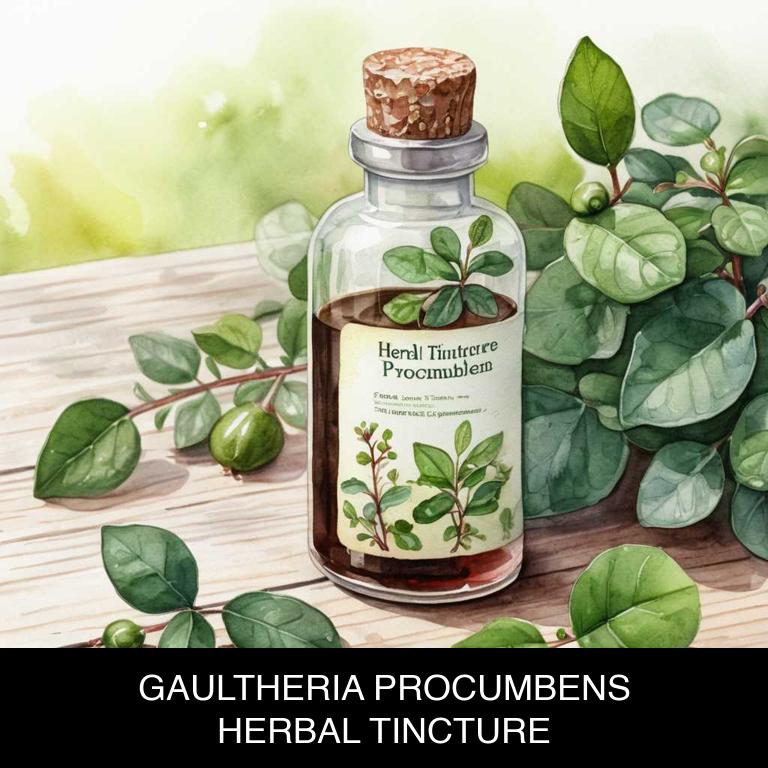
Medicinal Constituents
The list below shows the primary medicinal constituents in Gaultheria procumbens tinctures that help with burning feet.
- Salicin: A glycoside that acts as a natural analgesic and anti-inflammatory, helping to reduce pain and inflammation associated with burning feet.
- Methyl salicylate: A natural pain-relieving compound similar to aspirin, which can help alleviate burning sensations and discomfort in the feet.
- Gaultherin: A phenolic compound with anti-inflammatory and antioxidant properties, which can help soothe and protect the skin from irritation and inflammation that may be contributing to burning feet.
Parts Used
The list below shows the primary parts of wintergreen used to make tinctures for burning feet.
- Roots: They contain high levels of salicylic acid and other compounds that help reduce inflammation and pain associated with burning feet.
- Leaves: Rich in phenolic compounds, the leaves of Gaultheria procumbens may help soothe and calm the skin, reducing discomfort and burning sensations.
- Barks: Gaultheria procumbens barks have anti-inflammatory and astringent properties, which may aid in reducing inflammation and promoting wound healing on the affected areas.
Quick Recipe
The following recipe gives a procedure to make a basic wintergreen for burning feet.
- Gather 1 part of fresh gaultheria procumbens leaves and stems and 2 parts of vodka in a clean glass jar.
- Steep the gaultheria procumbens mixture in the vodka for 2 to 6 weeks in a cool dark place.
- Strain the liquid through cheesecloth or a coffee filter into a clean glass bottle to remove the solids.
- Discard the solids and store the gaultheria procumbens tincture in a cool dark place for up to 2 years.
- Use 20 to 30 drops of the gaultheria procumbens tincture in water or other liquid as needed.
7. Echinacea angustifolia
Kansas coneflower tinctures helps with burning feet because of its natural anti-inflammatory properties.
The herb, also known as Echinacea, contains compounds that soothe and calm irritated skin, reducing discomfort and pain caused by burning sensations. Additionally, the antiseptic and antibacterial properties help to prevent infection and promote healthy foot tissue, further alleviating burning sensations.
Regular use of Kansas coneflower tinctures can provide long-lasting relief from burning feet, allowing individuals to enjoy their daily activities without discomfort or distraction.
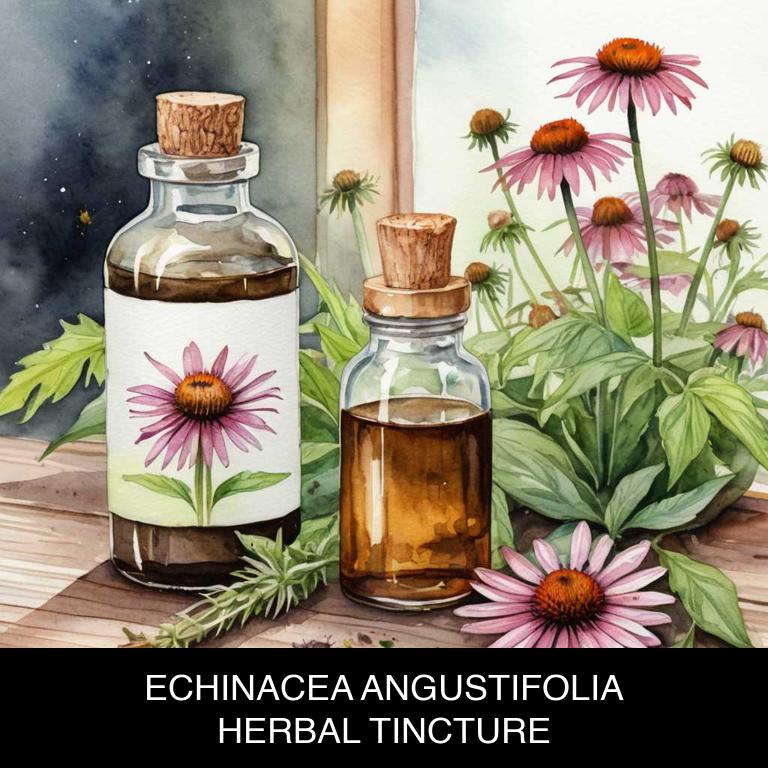
Medicinal Constituents
The list below shows the primary medicinal constituents in Echinacea angustifolia tinctures that help with burning feet.
- Iridoid glycosides: These compounds help to reduce inflammation and ease pain in the feet, thereby alleviating burning sensations caused by irritation or overuse.
- Flavonoids: Flavonoids present in Echinacea angustifolia have anti-inflammatory and antioxidant properties, which help to soothe and protect the skin, reducing discomfort and burning sensations in the feet.
- Alkaloids: Alkaloids like Cichoric Acid in Echinacea angustifolia have anti-inflammatory and antioxidant properties, which help to reduce swelling and ease pain in the feet, making it easier to manage burning sensations.
Parts Used
The list below shows the primary parts of kansas coneflower used to make tinctures for burning feet.
- Roots: They contain compounds like isobutylamides, which have anti-inflammatory and antimicrobial properties to help soothe burning feet.
- Leaves: They are rich in antioxidants and have anti-inflammatory properties, which can help reduce discomfort and pain in burning feet.
- Barks: The bark of Echinacea angustifolia contains compounds like echinacin, which have anti-inflammatory and antimicrobial properties to help alleviate burning sensations in the feet.
Quick Recipe
The following recipe gives a procedure to make a basic kansas coneflower for burning feet.
- Harvest echinacea angustifolia roots in late summer or fall when the plant is in full bloom for 2-3 weeks.
- Clean and dry the harvested roots in a low-temperature oven at 105 degrees fahrenheit for 2 hours.
- Chop the dried roots into small pieces using a sharp knife to increase surface area for extraction.
- Steep 1 part of the chopped roots in 2 parts of 80-proof vodka in a clean glass jar for 4-6 weeks.
- Strain the liquid mixture through a cheesecloth into a separate container and discard the solids after 4-6 weeks.
8. Arnica montana
Mountain arnica tinctures helps with burning feet because of its anti-inflammatory and analgesic properties.
The tincture's active compounds, such as helenin and sesquiterpenes, penetrate deep into the skin to reduce swelling and ease pain. Additionally, mountain arnica's natural cooling effect provides soothing relief from hot and itchy sensations on the feet.
By targeting the root cause of discomfort, herbal mountain arnica tinctures offer a gentle yet effective solution for individuals seeking respite from burning feet symptoms.
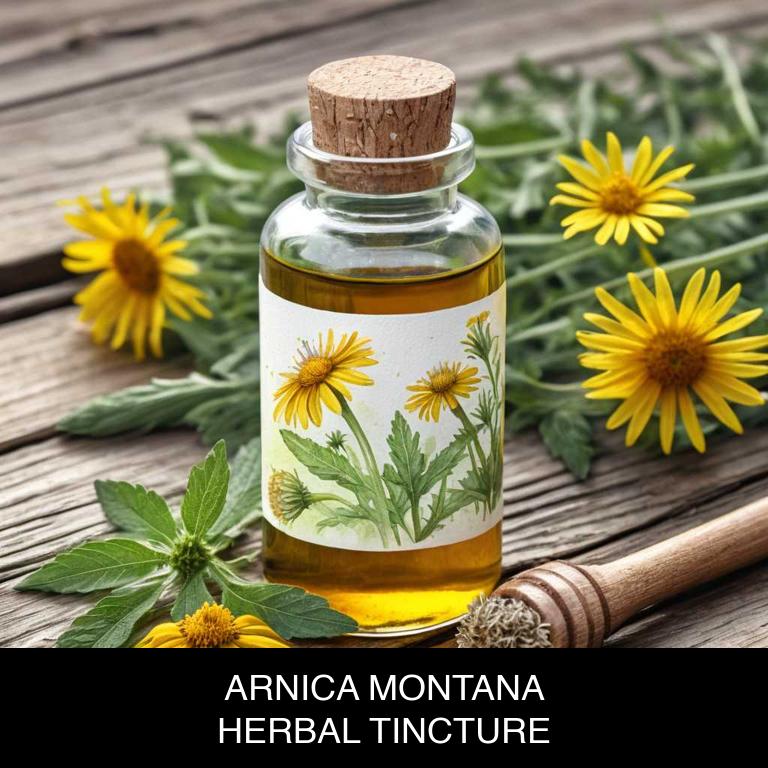
Medicinal Constituents
The list below shows the primary medicinal constituents in Arnica montana tinctures that help with burning feet.
- Thymol: Helps with burning feet by reducing inflammation and acting as an analgesic and antiseptic agent to soothe and calm the affected area.
- Tannins: Helps with burning feet by reducing inflammation, astringing tissues, and preventing excessive fluid loss, which can contribute to the burning sensation.
- Sesquiterpene lactones: Helps with burning feet by exhibiting anti-inflammatory and analgesic properties, which can help reduce pain and discomfort associated with burning feet.
Parts Used
The list below shows the primary parts of mountain arnica used to make tinctures for burning feet.
- Flowers: They are the most commonly used part due to their high concentration of sesquiterpene lactones, which have anti-inflammatory and analgesic properties.
- Roots: They are sometimes used in tinctures as they contain a higher concentration of sesquiterpene lactones compared to the flowers, although they are less commonly used.
Quick Recipe
The following recipe gives a procedure to make a basic mountain arnica for burning feet.
- Harvest 100 grams of fresh arnica montana flowers and leaves for their medicinal properties.
- Dry the harvested plant material in a low-temperature oven at 105 degrees fahrenheit for 2 hours.
- Chop the dried plant material into small pieces and combine 1 part with 2 parts of 95 percent ethanol in a clean glass jar.
- Steep the mixture for 2 to 6 weeks in a cool dark place, shaking the jar every day.
- Strain the liquid through a cheesecloth or coffee filter into another clean glass container, discarding the solids.
9. Sambucus nigra
Elder tinctures helps with burning feet because they contain antioxidants and anti-inflammatory compounds that help to soothe and calm irritated skin.
The bioactive compounds in elderberry, such as anthocyanins and flavonoids, have natural analgesic and antispasmodic properties, which can help to reduce discomfort and pain associated with burning feet.
Additionally, elder tinctures may also help to improve circulation and reduce inflammation, further alleviating symptoms of burning feet.
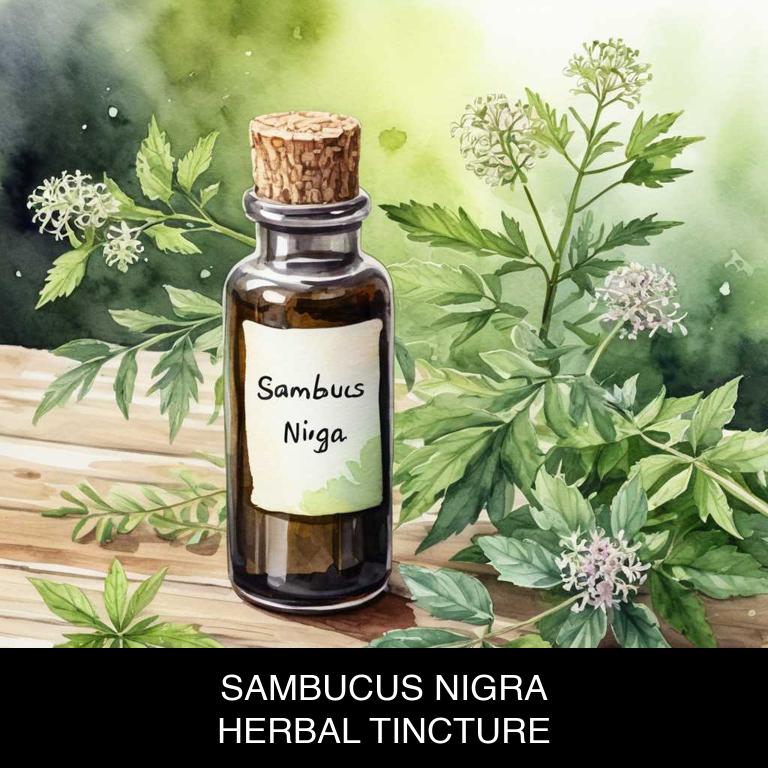
Medicinal Constituents
The list below shows the primary medicinal constituents in Sambucus nigra tinctures that help with burning feet.
- Flavonoids: These plant compounds have potent antioxidant and anti-inflammatory properties, which can help reduce inflammation and pain associated with burning feet.
- Phenolic acids: As a class of antioxidants, phenolic acids may help protect nerve endings from oxidative stress and inflammation, potentially alleviating burning sensations in the feet.
- Tannins: Tannins have anti-inflammatory and astringent properties, which can help soothe and calm irritated skin, reducing the discomfort and burning associated with conditions like athlete's foot or fungal infections.
Parts Used
The list below shows the primary parts of elder used to make tinctures for burning feet.
- Flowers: They are rich in antiseptic and anti-inflammatory properties that help soothe and calm burning feet.
- Leaves: They possess antimicrobial and antifungal properties that help combat fungal infections and reduce inflammation associated with burning feet.
- Buds: They contain compounds that help reduce inflammation and promote healing, making them useful for relieving burning foot symptoms.
Quick Recipe
The following recipe gives a procedure to make a basic elder for burning feet.
- Harvest 250 grams of fresh sambucus nigra flowers when they are fully open and in bloom.
- Dry the flowers in a single layer on paper bags or a drying rack for 1 week.
- Use a glass jar to steep 250 grams of dried sambucus nigra flowers in 1 liter of vodka at a ratio of 1:5 for 4-6 weeks.
- Strain the liquid through a cheesecloth or a coffee filter into another glass jar to remove the solids.
- Store the tincture in a cool dark place for 2-3 weeks before using it as needed.
10. Calendula officinalis
Pot marigold tinctures helps with burning feet because of its potent anti-inflammatory properties, which soothe and calm irritated skin.
The tannins present in the plant help to reduce swelling and ease discomfort, providing quick relief from the sensation of burning or tingling on the feet. Additionally, the antioxidant properties of pot marigold tincture help to combat oxidative stress, reducing inflammation and promoting overall foot health.
As a result, regular use of this herbal remedy can bring significant relief from burning feet symptoms.

Medicinal Constituents
The list below shows the primary medicinal constituents in Calendula officinalis tinctures that help with burning feet.
- Sesquiterpenes: These compounds, including calendulene, contribute to the anti-inflammatory and soothing effects of Calendula, which can help reduce burning sensations in the feet.
- Flavonoids: Acting as antioxidants and anti-inflammatory agents, flavonoids help alleviate pain and inflammation associated with burning feet, promoting a sense of relief and comfort.
- Tannins: Tannins have been shown to possess analgesic and anti-inflammatory properties, which can help reduce the burning sensation and discomfort in the feet, promoting a more comfortable and pain-free state.
Parts Used
The list below shows the primary parts of pot marigold used to make tinctures for burning feet.
- Flowers: They are used to make tinctures due to their anti-inflammatory and antiseptic properties, which can help soothe and calm burning feet.
- Leaves: They are used to make tinctures due to their antimicrobial properties, which can aid in reducing infections and inflammation that may cause burning sensations in the feet.
- Roots: They are used to make tinctures due to their antiseptic and anti-inflammatory properties, which can help to reduce swelling and pain in the feet.
Quick Recipe
The following recipe gives a procedure to make a basic pot marigold for burning feet.
- Gather and clean 250 grams of dried calendula officinalis flowers to ensure freshness and quality.
- Combine the dried flowers with 750 milliliters of 95% ethanol in a clean glass jar.
- Store the mixture in a cool dark place for 2 to 6 weeks to allow infusion.
- Strain the liquid through cheesecloth or a coffee filter into a separate container to remove solids.
- Discard the solids and transfer the tincture to dark glass bottles with dropper lids for storage.
What is the best combination of herbal tinctures to use for burning feet?
The best combination of herbal tinctures that help with burning feet is a blend of peppermint, aloe vera, and witch hazel.
Peppermint cools and soothes the skin, while aloe vera provides moisturizing properties to hydrate and calm the area. Witch hazel reduces inflammation and itching, promoting quick recovery.
Together, these tinctures form a powerful synergy that not only alleviates burning sensations but also promotes skin health, making them a natural and effective solution for individuals suffering from burning feet.
What ailments similar to burning feet are treated with herbal tinctures?
Ailments similar to burning feet that are treated with herbal tinctures are conditions characterized by discomfort, inflammation, and pain.
For example, herbal tinctures are used to alleviate symptoms of sciatica, shin splints, and plantar fasciitis, which can cause burning sensations in the legs.
Additionally, tinctures are also employed to treat conditions like restless leg syndrome, nerve damage, and peripheral neuropathy, all of which share similarities with burning foot syndrome.